
|   |

|   |
Kathak dancers enthrall viewers with fluid rhythmic movement in Sankhya - Dr. S.D. Desai e-mail: sureshmrudula@gmail.com Photos: Divyom Mehta December 6, 2022 Beaming with joy, Ishira Parikh, founder of Anart Foundation with Maulik Shah, both eminent Kathak Gurus felicitated with Fellowship by SNA, after the performance of Sankhya at Abhivyakti on Nov 25 (Upasana Sch., GU Amphitheatre) casually observed to the large audience that stood up as a gesture of ovation to the performance that they had found enthralling, "This is our legacy." There could not have been a more treasurable testimony to the originality of the concept and the quality of the performance the young ebullient Kathak dancers had displayed under the guidance of their young mentors and faculty, Raina and Kadam Parikh. In the traditional Ginti in Kathak, it is a counting aloud of numbers in the ascending or descending order with limited hand gestures in tune with the percussion rhythm that delights both the dancer and the audience. The budding Kathak duo Raina-Kadam's originality in Sankhya was in relating each of the numbers 1 to 7 in their downward pattern to some of the visual images from our mythology and iconography. In portraying them imaginatively, they employed fluid rhythmic movement, at times punctuated for a second or two with a graceful stance, in key with the soulful music and poetry or lyrical prose lines. They were prompted to undertake this creative process by stirring evocative stanzas from Ishira's poem in Hindi. Rangabirangi is duniya mein ... 'Whoever knows what lies gleaming beneath this universe!' Ras ki gathri khuli re khuli: Her pithy lyrical lines, difficult to translate, tantalize. They promise mystifying ingredients waiting to be scooped out of a magic pot. The line visualized with the dancers' smiling wonderment evokes viewers' imagination. Seven rainbow colours unfolding with seven musical notes, for example, have the viewers' expectant hearts leaping with anticipation. From here on for an hour is an experience with the eye, the ear and at times the sixth sense within that becomes cherished. 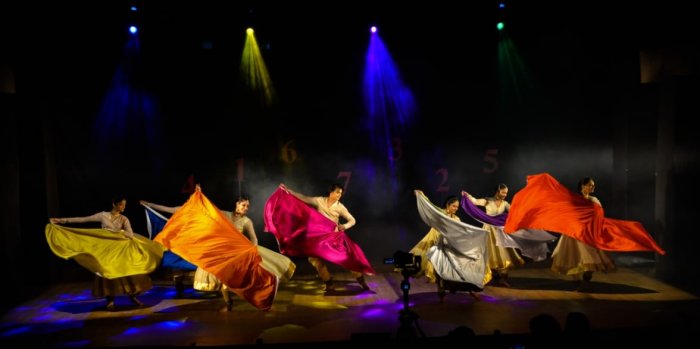 Seven 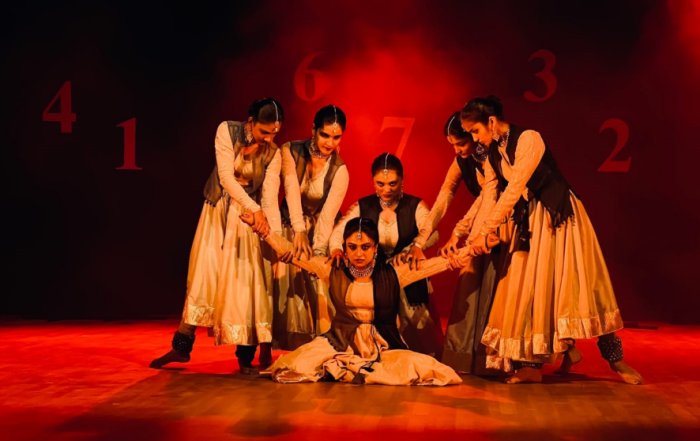 Six Beware, the next segment gently cautions. You need to keep sensibility in place to be part of the joyous universe. Beware of the six invisible adversaries, shadripus - attachment (मोह), desires (काम), greed (लोभ), ego (मद), envy (मत्सर), anger (क्रोध). Anyone trapped in them loses sense, a line says. What is visually portrayed, loud otherwise, looks artistically controlled - and graceful. There are hints of a conflict - with stance, movement, eyes, footwork, formations and music - for a newly wed girl dispelling her dream of a rainbow in life. Her struggle and triumph in overcoming hostile forces bring in a welcome social angle. This paves way, as it were, for five fold sensory pleasures of sight, smell, taste, touch and hearing given exclusively to humans. Only a change in rhythm leads to the transition. The dancers (Naisargi, Priyanka, Yesha, Pankhi, Pari) led by Raina-Kadam, who have given shape to the production with concept and artistic direction respectively, joyously get one with the universe varyingly offering these pleasures. Sequence remains significant in this dainty dance piece guided with a sense for oral and visual beauty and balance. 'Gurus have all through evaluated our ideas in each segment and have with their insights given the Midas touch to the production,' the visualizing duo of their maiden production effusively share. Parth Raval's (lights) and Anuvi Desai's (costumes) work does not go unnoticed. 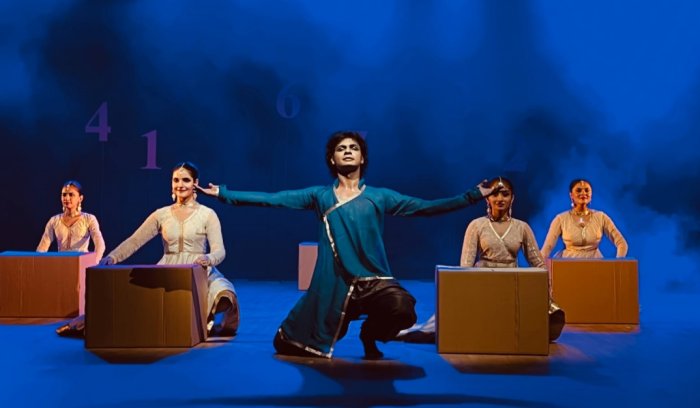 Five 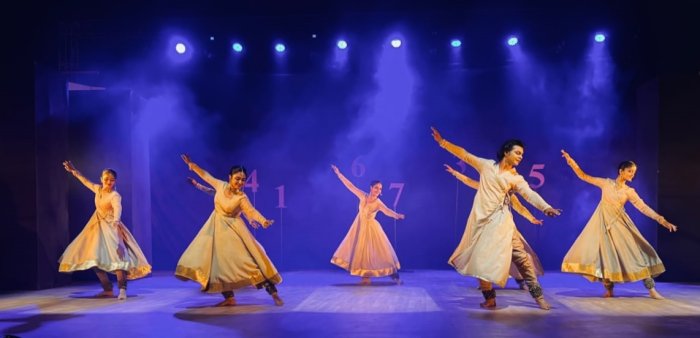 Four The joy of the dancers' sensory perceptions culminates when the exhilarating luxuriance of nature the four seasons display. They are ushered in by Kadam's Soorya namaskar (Duration does not leave much scope for the sun's splendour.) Warm salubrious sunrays, cozy winter inviting togetherness, freshening cool raindrops, the dancing peacock, the refreshing breeze and changing raag patterns (Bhairav-Hemant-Malhar-Basant) spell and permeate each characteristic mood. A classy and classical presentation in terms of music (Nishith Mehta) and dance predominate in the segment for three. The image that especially remains cherished is a composite image of the three legendary goddesses each capable of bestowing on Her steadfast follower a boon: Saraswati (Vidya), Lakshmi (Aishvarya) and Durga (Urja). 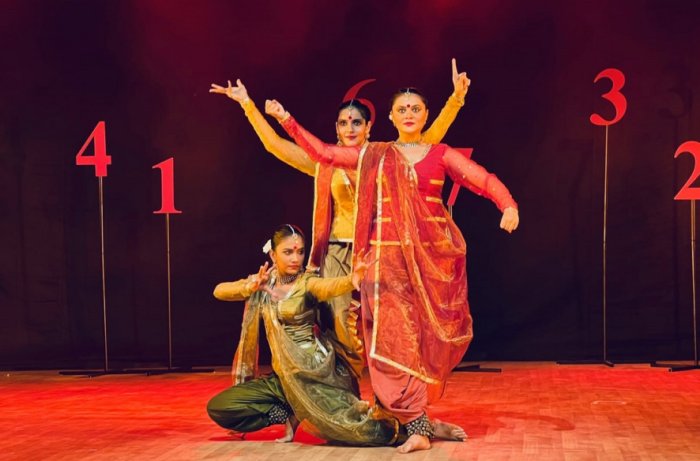 Three 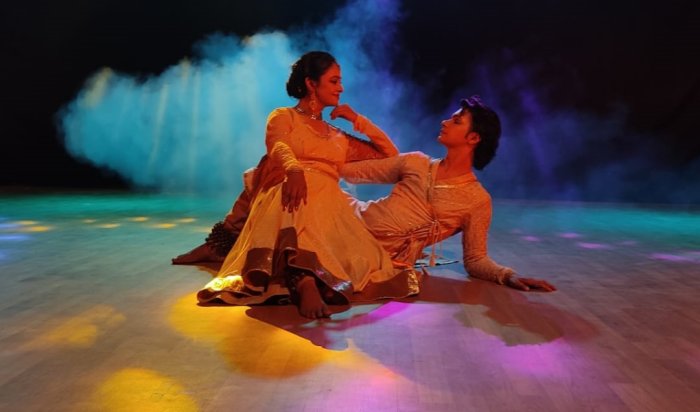 Two In two, viewers get to see signature images of the dancers' gurus for Sayujya reproduced by the young dancing couple Raina and Kadam. Sayujya with two complementary images of purush and prakriti merging and enhancing each other's grace, dignity and power with the potential for creative work together has a universal appeal - even without it spiritual connotations. Bhinna hai aakruti, bhinna hai prakruti, magar sayujya ki ek anokhi anubhooti (Different in appearance, different in nature, but the togetherness of the two creates a feeling beyond compare of being one). The idea that either of the two, good enough to look at but incomplete, gets a meaning when combined is illustrated with also a simple graphic. Viewers, all quietly participating in the apparently playful but intrinsically meaningful ginti, have the expected climactic moment when finally Mein khaas hu-n (I have my own identity) emerges on the stage in the pleasing form of Raina Parikh - as a young person 'having dreams and aspirations, having the capability for all sensory pleasures, feeling satiated now, now longing for more, mind full of ideas, I love myself!' The dancer oozes confidence. Her head held high, body erect and sliding gait balanced speak for a sensitive individual the character portrayed is. 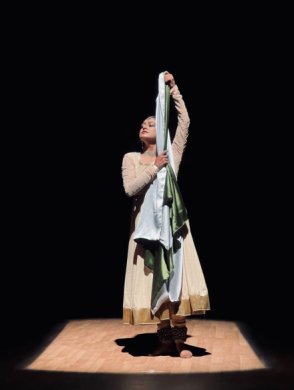 One It is significant that even as the performance spells out positive energies and joys life offers, it has the graceful dignity and sensitivity of a woman in the centre. Being nonverbal, the portrayal has artistic dimensions, which can get aesthetically even sharper with experience in the power of expression.  Dr. S.D. Desai, a professor of English, has been a Performing Arts Critic for many years. Among the dance journals he has contributed to are Narthaki, Sruti, Nartanam and Attendance. His books have been published by Gujarat Sahitya Academy, Oxford University Press and Rupa. After 30 years with a national English daily, he is now a freelance art writer. |